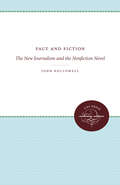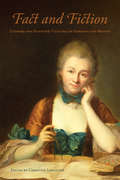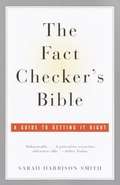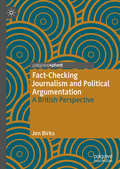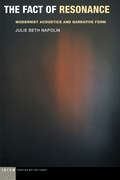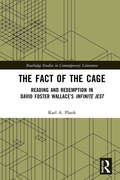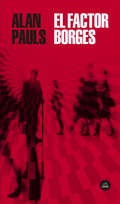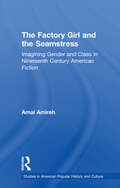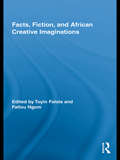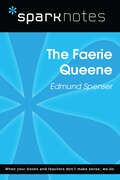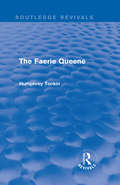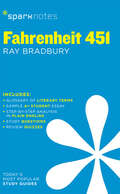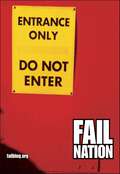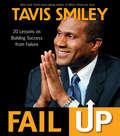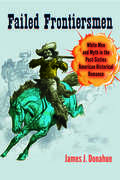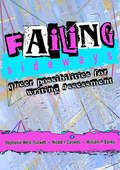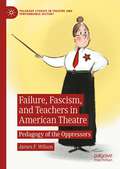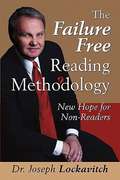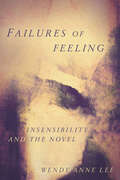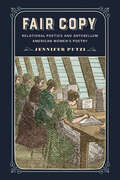- Table View
- List View
Fact and Fiction: The New Journalism and the Nonfiction Novel
by John HollowellJournalists and novelists responded to the pervasive social changes of the 1960s in America with a variety of experiments in nonfiction. Those who have praised the vitality of the new journalism have seen it as a fusion of the journalist's passion for detail and the novelist's moral vision. Hollowell presents a critically sharp portrait of what the new journalists and novelists are doing and why. The author concludes that future writing will further obscure the difference between fact and fiction.Originally published in 1977.A UNC Press Enduring Edition -- UNC Press Enduring Editions use the latest in digital technology to make available again books from our distinguished backlist that were previously out of print. These editions are published unaltered from the original, and are presented in affordable paperback formats, bringing readers both historical and cultural value.
Fact and Fiction: Literary and Scientific Cultures in Germany and Britain
by Christine LehleiterFact and Fiction explores the intersection between literature and the sciences, focusing on German and British culture between the eighteenth century and today. Observing that it was in the eighteenth century that the divide between science and literature as disciplines first began to be defined, the contributors to this collection probe how authors from that time onwards have assessed and affected the relationship between literary and scientific cultures.Fact and Fiction's twelve essays cover a wide range of scientific disciplines, from physics and chemistry to medicine and anthropology, and a variety of literary texts, such as Erasmus Darwin's poem The Botanic Garden, George Eliot's Daniel Deronda, and Goethe's Elective Affinities. The collection will appeal to scholars of literature and of the history of science, and to those interested in the connections between the two.
The Fact Checker's Bible: A Guide to Getting It Right
by Sarah Harrison SmithThe first book of its kind,The Fact Checker’s Bibleis the essential guide to the important but often neglected task of checking facts, whatever their source. Today, everyone is overwhelmed with information that claims to be factual. But even the most punctilious researcher, writer, student or journalist--not to mention the lazy or deliberately mendacious ones--can sometimes get it wrong. So checking facts has become a more pressing task. But how to go about it? The Fact Checker’s Biblecovers: *Reading for accuracy *Determining what to check *Researching the facts *Assessing sources: people, newspapers and magazines, books, the Internet, etc. *Checking quotations *Understanding the legal liabilities of getting it wrong *Looking out for and avoiding the dangers of plagiarism For everyone from students to editors to journalists, the methods and practices outlined inThe Fact Checker’s Bibleprovides both a standard and a working manual for how to get the facts right. From the Trade Paperback edition.
Fact-Checking Journalism and Political Argumentation: A British Perspective
by Jen BirksThis timely book examines the role of fact-checking journalism within political policy debates, and its potential contribution to public engagement. Understanding facts not to operate in a political vacuum, the book argues for a wide remit for fact-checking journalism beyond empirically-checkable facts, to include the causal relationships and predictions that form part of wider political arguments and are central to electoral pledges. Whilst these statements cannot be proven or disproven, fact-checking can, and sometimes does, ask pertinent critical questions about the premises of those claims and arguments. The analysis centres on the three dedicated national British fact-checkers during the UK’s 2017 snap general election, including their activity and engagement on Twitter. The book also makes a close political discourse and argumentation analysis of three key issue debates in flagship reporting from Channel 4 News and the BBC.
Fact in Fiction: The use of literature in the systematic study of society (Routledge Revivals)
by Joan RockwellFirst published in 1974, Fact in Fiction states that literature does not ‘reflect’ or ‘arise from’ society but is as much a functioning part of it as any social structure, institution or set of norms. The author shows that, however fantastic the content of fiction, it is a representation of social fact, not the mere random issue of private fantasy. Because of this, there is a regular and discernible pattern in which literature is related to other strands in the social web, which makes it possible to ‘read back’ from fiction to other social fact. An explanation is put forward for the normative power of fiction, from its origins in the apparent human necessity to communicate abstract concepts in terms of narrative accounts of human action. This book will be of interest to students of literature, sociology and history.
The Fact of Resonance: Modernist Acoustics and Narrative Form (Idiom: Inventing Writing Theory)
by Julie Beth NapolinShortlisted, 2021 Memory Studies Association First Book AwardThe Fact of Resonance returns to the colonial and technological contexts in which theories of the novel developed, seeking in sound an alternative premise for theorizing modernist narrative form. Arguing that narrative theory has been founded on an exclusion of sound, the book poses a missing counterpart to modernism’s question “who speaks?” in the hidden acoustical questions “who hears?” and “who listens?”For Napolin, the experience of reading is undergirded by the sonic. The book captures and enhances literature’s ambient sounds, sounds that are clues to heterogeneous experiences secreted within the acoustical unconscious of texts. The book invents an oblique ear, a subtle and lyrical prose style attuned to picking up sounds no longer hearable. “Resonance” opens upon a new genealogy of modernism, tracking from Joseph Conrad to his interlocutors—Sigmund Freud, Frantz Fanon, W. E. B. Du Bois, William Faulkner, and Chantal Akerman—the racialized, gendered, and colonial implications of acoustical figures that “drift” through and are transformed by narrative worlds in writing, film, and music.A major synthesis of resources gleaned from across the theoretical humanities, the book argues for “resonance” as the traversal of acoustical figures across the spaces of colonial and technological modernity, figures registering and transmitting transformations of “voice” and “sound” across languages, culture, and modalities of hearing. We have not yet sufficiently attended to relays between sound, narrative, and the unconscious that are crucial to the ideological entailments and figural strategies of transnational, transatlantic, and transpacific modernism. The breadth of the book’s engagements will make it of interest not only to students and scholars of modernist fiction and sound studies, but to anyone interested in contemporary critical theory.
The Fact of the Cage: Reading and Redemption In David Foster Wallace’s "Infinite Jest" (Routledge Studies in Contemporary Literature)
by Karl A. PlankDavid Foster Wallace’s Infinite Jest raised expectations of what a novel might do. As he understood fiction to aim at what it means to be human, so he hoped his work might relieve the loneliness of human suffering. In that light, The Fact of the Cage shows how Wallace’s masterpiece dramatizes the condition of encagement and how it comes to be met by "Abiding" and through inter-relational acts of speaking and hearing, touching, and facing. Revealing Wallace’s theology of a "boneless Christ," The Fact of the Cage wagers that reading such a novel as Infinite Jest makes available to readers the redemption glimpsed in its pages, that reading fiction has ethical and religious significance—in short, that reading Infinite Jest makes one better. As such, Plank’s work takes steps to defend the ethics of fiction, the vital relation between religion and literature, and why one just might read at all.
Fact or Opinion Reading Comprehension Book: Reading Level 3.5-5.0
by EdupressThis resource is an effective tool for instruction, practice, and evaluation of student understanding. It includes ideas on how to introduce fact or opinion to students, as well as activities to help teach and practice the concept.
El factor Borges: Nueve Ensayos Ilustrados (Tezontle/fondo De Cultura Económica Ser.)
by Alan Pauls¿Cuál es la clave, la contraseña o la molécula inigualable que constituye la esencia de lo borgeano? Alan Pauls hilvana, a su manera, un manual de instrucciones que da cuenta de la obra más importante que dio la literatura argentina. Pero más que un conjunto de ensayos críticos, El factor Borges atraviesa los principales conceptos asociados a ese universo -originalidad, tradición, biblioteca- para mapear no solo el núcleo de sus textos, sino también la configuración de su identidad. Una búsqueda tan profunda como incesante por la imagen que proyectó durante su vida y de manera póstuma y, por supuesto, esa maquinaria perfecta que se anticipó a su tiempo y trasciende su propia sintaxis. También lo que no siempre llegamos a considerar sobre Borges encuentra una dimensión en este libro. Incluso su perseverante naturaleza pendenciera y esas estrategias sutiles pero significativas que Pauls interpreta de manera magistral, como la aparente coquetería de quitarse solo un año de edad para coincidir exactamente con el siglo que le tocó vivir.
The Factory Girl and the Seamstress: Imagining Gender and Class in Nineteenth Century American Fiction (Studies in American Popular History and Culture)
by Amal AmirehThis book studies the representations of working-class women in canonical and popular American fiction between 1820 and 1870. These representations have been invisible in nineteenth century American literary and cultural studies due to the general view that antebellum writers did not engage with their society's economic and social relaities. Against this view and to highlight the cultural importance of working-class women, this study argues that, in responding to industrialization, middle class writers such as Melville, Hawthorne, Fern, Davies, and Phelps used the figures of the factory worker and the seamstress to express their anxieties about unstable gender and class identitites. These fictional representations were influenced by, and contributed to, an important but understudied cultural debate about wage labor, working women, and class.
Facts, Fiction, and African Creative Imaginations (Routledge African Studies)
by Toyin Falola Fallou NgomThis volume brings together insights from distinguished scholars from around the world to address the facts, fiction and creative imaginations in the pervasive portrayals of Africa, its people, societies and cultures in the literature and the media. The fictionalization of Africa and African issues in the media and the popular literature that blends facts and fiction has rendered perceptions of Africa, its cultures, societies, customs, and conflicts often superficial and deficient in the popular Western consciousness. The book brings eminent scholars from a variety of disciplines to sort out the persistent fictionalization of Africa, from facts pertaining to the genesis of powerful cultural, political or religious icons, the historical and cultural significance of "intriguing" customs (such as tribal marks), gender relations, causes of conflicts and African responses, and creative imaginations in contemporary African films, fiction and literature, among others.
The Faerie Queen (SparkNotes Literature Guide Series)
by SparkNotesThe Faerie Queen (SparkNotes Literature Guide) by Edmund Spenser Making the reading experience fun! Created by Harvard students for students everywhere, SparkNotes is a new breed of study guide: smarter, better, faster.Geared to what today's students need to know, SparkNotes provides:chapter-by-chapter analysis explanations of key themes, motifs, and symbols a review quiz and essay topics Lively and accessible, these guides are perfect for late-night studying and writing papers.
The Faerie Queene (Routledge Revivals)
by Humphrey TonkinEdmund Spenser’s The Faerie Queene is among the most important literary products of the Elizabethan age, and the vast sweep of its moral, political and social concerns tells us more about the age than any other work. This volume, first published in 1989, offers detailed readings of each of the poem’s seven books, along with introductory chapters on Spenser’s career, and the roots of the poem in the English and continental traditions. Humphrey Tonkin pays particular attention to the work’s political and cultural role and its contribution to the development of Elizabethan ideology. A comprehensive analysis, this reissue will be of particular value to literature students and academics alike.
Fahrenheit 451 SparkNotes Literature Guide (SparkNotes Literature Guide Series)
by SparkNotes Ray BradburyFahrenheit 451 SparkNotes Literature Guide by Ray Bradbury Making the reading experience fun! When a paper is due, and dreaded exams loom, here's the lit-crit help students need to succeed! SparkNotes Literature Guides make studying smarter, better, and faster. They provide chapter-by-chapter analysis; explanations of key themes, motifs, and symbols; a review quiz; and essay topics. Lively and accessible, SparkNotes is perfect for late-night studying and paper writing. Includes:An A+ Essay—an actual literary essay written about the Spark-ed book—to show students how a paper should be written.16 pages devoted to writing a literary essay including: a glossary of literary termsStep-by-step tutoring on how to write a literary essayA feature on how not to plagiarize
Fail Nation: A Visual Romp Through The World Of Epic Fails
by failblog.orgFrom the underbelly of the nuts behind hit websites failblog.org and icanhascheezburger.com comes FAIL Nation, your silent guide and handler to the not-even-close-to-perfect nation of FAIL, chock-full of irrelevant tips and useless suggestions about why to shop, who to eat, and when to see. So fasten your exit and check for the nearest seatbelt—your FAIL plane departs now.
Fail Up: 20 Lessons On Building Success From Failure
by Tavis Smiley"Failure is an inevitable part of the human journey," says award-winning television and radio broadcaster and New York Times best-selling author Tavis Smiley. Smiley steps from behind the curtain of success to share intimate stories of his missteps, misdeeds, and often highly publicized miscalculations in Fail Up: 20 Lessons On Building Success From Failure. These instances of perceived "failures" were, in fact, "lessons" that shaped the principles and practices that now guide his life. Readers will find a kinship in Smiley’s humanness that inspires, informs, and reminds us of our ability to "fail up" in the face of life’s inevitable setbacks. The year-long celebration of Smiley’s 20th year anniversary in broadcasting will feature the Fail Up book tour.
Failed Frontiersmen: White Men and Myth in the Post-Sixties American Historical Romance (Cultural Frames, Framing Culture)
by James J. DonahueIn Failed Frontiersmen, James Donahue writes that one of the founding and most persistent mythologies of the United States is that of the American frontier. Looking at a selection of twentieth-century American male fiction writers—E. L. Doctorow, John Barth, Thomas Pynchon, Ishmael Reed, Gerald Vizenor, and Cormac McCarthy—he shows how they reevaluated the historical romance of frontier mythology in response to the social and political movements of the 1960s (particularly regarding the Vietnam War, civil rights, and the treatment of Native Americans). Although these writers focus on different moments in American history and different geographic locations, the author reveals their commonly held belief that the frontier mythology failed to deliver on its promises of cultural stability and political advancement, especially in the face of the multicultural crucible of the 1960s. Cultural Frames, Framing Culture American Literatures Initiative
Failing Sideways: Queer Possibilities for Writing Assessment
by Stephanie West-Puckett Nicole I. Caswell William P. BanksFailing Sideways is an innovative and fresh approach to assessment that intersects writing studies, educational measurement, and queer rhetorics. While valuing and representing the research, theory, and practice of assessment, authors Stephanie West-Puckett, Nicole I. Caswell, and William P. Banks demonstrate the ways that students, teachers, and other interested parties can find joy and justice in the work of assessment. A failure-oriented assessment model unsettles some of the most common practices, like rubrics and portfolios, and challenges many deeply held assumptions about validity and reliability in order to ask what could happen if assessment was oriented toward possibility and potential. Working to engage a more capacious writing construct, the authors propose queer validity inquiry (QVI) as a model for assessment that values failure, affect, identity, and materiality. These overlapping lenses help teachers honor parts of writing and learning that writing studies faculty have struggled to hold onto in a world overly focused on quickness and efficiency in schools. Through programmatic and classroom examples, Failing Sideways privileges what is valued in the classroom but traditionally ignored in assessments. Reimagining what matters in the teaching and learning of writing and using assessment data differently, this book demonstrates what writing can be and could do in a more diverse and just world.
Failure and the American Writer
by Gavin JonesIf America worships success, then why has the nation's literature dwelled obsessively on failure? This book explores encounters with failure by nineteenth-century writers - ranging from Edgar Allan Poe and Herman Melville to Mark Twain and Sarah Orne Jewett - whose celebrated works more often struck readers as profoundly messy, flawed, and even perverse. Reading textual inconsistency against the backdrop of a turbulent nineteenth century, Gavin Jones describes how the difficulties these writers faced in their faltering search for new styles, coherent characters, and satisfactory endings uncovered experiences of blunder and inadequacy hidden in the culture at large. Through Jones's treatment, these American writers emerge as the great theorists of failure who discovered ways to translate their own social insecurities into complex portrayals of a modern self, founded in moral fallibility, precarious knowledge, and negative feelings.
Failure, Fascism, and Teachers in American Theatre: Pedagogy of the Oppressors (Palgrave Studies in Theatre and Performance History)
by James F. WilsonThis timely and accessible book explores the shifting representations of schoolteachers and professors in plays and performances primarily from the twentieth and twenty-first centuries in the United States. Examining various historical and recurring types, such as spinsters, schoolmarms, presumed sexual deviants, radicals and communists, fascists, and emasculated men teachers, Wilson shines the spotlight on both well-known and nearly-forgotten plays. The analysis draws on a range of scholars from cultural and gender studies, queer theory, and critical race discourses to consider teacher characters within notable education movements and periods of political upheaval. Richly illustrated, the book will appeal to theatre scholars and general readers as it delves into plays and performances that reflect cultural fears, desires, and fetishistic fantasies associated with educators. In the process, the scrutiny on the array of characters may help illuminate current attacks on real-life teachers while providing meaningful opportunities for intervention in the ongoing education wars.
The Failure Free Reading Methodology: New Hope for Non-readers
by Joseph LockavitchThis book provides the insight into a new corrective reading action. The time has come to stop giving up on failing students and this book shows how.
Failures of Feeling: Insensibility and the Novel
by Wendy Anne LeeThis book recovers the curious history of the "insensible" in the Age of Sensibility. Tracking this figure through the English novel's uneven and messy past, Wendy Anne Lee draws on Enlightenment theories of the passions to place philosophy back into conversation with narrative. Contemporary critical theory often simplifies or disregards earlier accounts of emotions, while eighteenth-century studies has focused on cultural histories of sympathy. In launching a more philosophical inquiry about what emotions are, Failures of Feeling corrects for both of these oversights. Proposing a fresh take on emotions in the history of the novel, its chapters open up literary history's most provocative cases of unfeeling, from the iconic scrivener who would prefer not to and the reviled stock figure of the prude, to the heroic rape survivor, the burnt-out man-of-feeling, and the hard-hearted Jane Austen herself. These pivotal cases of insensibility illustrate a new theory of mind and of the novel predicated on an essential paradox: the very phenomenon that would appear to halt feeling and plot actually compels them. Contrary to the assumption that fictional investment relies on a richness of interior life, Lee shows instead that nothing incites the passions like dispassion.
Fair Copies
by Matthew ZarnowieckiIn the latter half of the sixteenth century, English poets and printers experimented widely with a new literary format, the printed collection of lyric poetry. They not only investigated the possibilities of working with a new medium, but also wrote metaphors of human reproduction directly into their works. In Fair Copies, Matthew Zarnowiecki argues that poetic production was re-envisioned during this period, which was rife with models of copying and imitation, to include reproduction as one of its inherent attributes.Tracing the development of the English lyric during this crucial period, Fair Copies incorporates a diverse range of cultural productions and reproductions - from key poetic texts by Shakespeare, Sidney, Spenser, Gascoigne, and Tottel to legal breviaries, visual representations of song, midwives' manuals, and commonplace books. Also included are fifteen facsimile reproductions of poems in early printed books, with explanations and discussions of their importance. Calling upon these diverse sources, and examining lyric poems in their earliest manuscript and printed contexts, Zarnowiecki develops a new, reproductively centred method of reading early modern English lyric poetry.
Fair Copy: Relational Poetics and Antebellum American Women's Poetry (Material Texts)
by Jennifer PutziIn Fair Copy Jennifer Putzi studies the composition, publication, and circulation of American women's poetry in the antebellum United States. In opposition to a traditional scholarly emphasis on originality and individuality, or a recovery method centered on author-based interventions, Putzi proposes a theory and methodology of relational poetics: focusing on poetry written by working-class and African American women poets, she demonstrates how an emphasis on relationships between and among people and texts shaped the poems that women wrote, the avenues they took to gain access to print, and the way their poems functioned within a variety of print cultures. Yet it is their very relationality which has led to these poems and the poets who published them being written out of literary history. Fair Copy models a radical reading and recovery of this work in a way that will redirect the study of nineteenth-century American women's poetry.Beginning with Lydia Huntley Sigourney and ending with Elizabeth Akers Allen and Frances Ellen Watkins Harper, Putzi argues that relational practices like imitation, community, and collaboration distinguished the poetry of antebellum American women, especially those whose access to print was mediated by class or race. To demonstrate this point, she recovers poetry by the "factory girls" of the Lowell Offering, African American poet Sarah Forten, and domestic servant Maria James, whose volume Wales, and Other Poems was published in 1839. Putzi's work reveals a careful navigation of the path to print for each of these writers, as well as a fierce claim to poetry and all that it represented in the antebellum United States.
